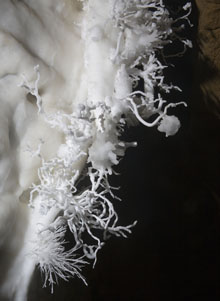Caves are a special and rare environment, some more so than others, and parts of some more so than others.
Active stream passages and potholes with fast moving water may have very little that can be accidentally damaged by the passage of a caver.
On the other hand, fossil cave passages where streams never flow are likely to contain all sorts of delicate remains that could be easily damaged by the passage of a single thoughtless caver. Where there is a risk of accidental damage, whilst passing delicate straw stalactites, or sand banks, approaching close to a crystal pools, for example, you should slow down, look carefully around you and take extreme care. Many of the more delicate areas of dry fossil passage are not the sort of place you would expect to find life.
All these features are easily damaged and cannot be repaired. The following is based on the British Caving Association Cave Conservation Code intended to minimise damage to caves.
Please read it and try to follow it whenever you go caving. Thank you.
1 CAVE WITH CAUTION and WITHIN YOUR OWN ABILITY and EXPERIENCE
If you are the leader/organiser always be aware of the abilities/limitations of ALL of the members of the party. The ‘Weakest Link’ must dictate the speed and extent of your trip – not the strongest! Tired cavers will not only damage themselves, they will damage the cave as well!
2 KEEP PARTY SIZE
Appropriate to the particular cave that you are visiting.
3 OBSERVE and KEEP TO TAPED ROUTES
In taped-off sections follow the path and do not cross the tapes. They are there for good reason.
4 DO NOT TOUCH FORMATIONS OR OTHER DELICATE ITEMS
These are easily broken or muddied – they must never be touched.
 |
War of the Worlds, Ogof Draenen |
5 KEEP AWAY FROM BATS OR OTHER LIFE
All bats are protected by the Wildlife and Countryside Act 1981. It is illegal to take or kill any bat, to disturb roosting bats, or damage, destroy or obstruct access to any place used by bats for roosting (roosting includes hibernation). It is illegal to handle bats, without a bat license. A license is usually required to photograph roosting and hibernating bats as the photography and flash can disturb the bats.
The more advanced creatures are the most likely to show obvious distressed behaviour in your presence e.g. bats, birds, otters and fish. Less advanced creatures may also change behaviour but there is less information available.
6 NEVER DIG WITHOUT PROPER CONSENT
Sand/mud banks are valuable sources of information about the cave and its surroundings, and might also contain archaeological remains. Do not dig or disturb without proper consent.
7 NEVER INTERFERE WITH SCIENTIFIC EQUIPMENT
Dedicated cave scientists put a lot of time, funding and effort into their research. Never touch any such equipment that you find in a cave.
8 LEAVE NO LITTER OR POLLUTION
Carbide lighting should be avoided and never used where bats are present. Where it is used take with you a suitable container for its safe removal from the cave. If you drop food it becomes a food source for an organism - in places like the Hard Rock Cafe camp in Darren Cilau the roof is covered in microbial growths, presumably dependant on cavers cooking beneath and the subsequent condensation carrying nutrients with it.
9 TAKE NOTHING OUT OF A CAVE
Do not remove anything from a cave except your own or others’ rubbish. In the past people have done great damage to some of our limestone areas by collecting moss from dry stone walls for hanging baskets, ferns for gardens, limestone pavement fragments and dry stone walls for rockeries.
10 TAKE PHOTOGRAPHS WITH CARE
A macro lens was used for the majority of the photographs on this web site. It is best to photograph them in situ - most will stay still for long enough for the flash to freeze any movement and camera shake so the majority of these pictures where taken without a tripod. Sometimes it is impossible to get the photograph you want because the creature is hiding in a crevice - leave it there and find another one rather than try to entice it out. They are used to life in the dark, as soon as you observe them with a light their behaviour may change, a flash may similarly affect their behaviour. Unfortunately you cannot see without light so it is difficult to assess your impact on the creatures.
Note that you need a license to photograph hibernating bats. |


